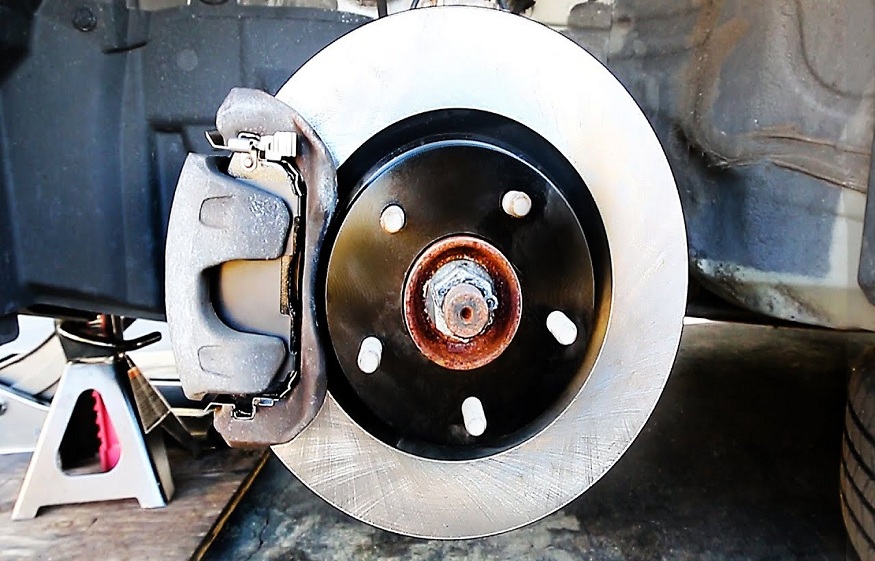Disc brakes have become the usual standard, technique used in modern automotive braking systems. Exit drum brakes, even if some brands are still resisting, especially in the rear axles of certain heavy vehicles or to equip the handbrake. Disc brakes, however, have one thing in common with their drum counterparts: the contact material wears out every time the brake pedal is pressed. This is normal wear, leading to the normal obsolescence of the part, the replacement of which is scheduled. Good news, disc brake pads are much easier and quicker to replace than drum brake linings. This job is well within the reach of an average handyman. Let’s see how to do it!
First, a bit of technique
As with every time a job is tackled, knowing the purpose of each element present and its role in the system greatly facilitates the method to be implemented and avoids many errors with more or less harmful consequences. First of all, disc brakes or drum brakes, the mode of operation is the same. A fixed surface (segment linings or pads) is forced to rub on a moving surface (drum or disc) to break its inertia. In this process, the disc brake system has only advantages: it is more efficient, simpler, cheaper, less heavy and easier to maintain. The device, which is extremely simple, is made up of the following elements for each wheel:
A metal disc, easier to ventilate than the old drums. This particularity makes all the difference, because braking largely loses effectiveness when the temperature, due to friction, increases. Admittedly, in both systems, there is heat production, but unlike drums, the discs can be hollowed out (as on motorcycles), or made up of two thin parallel discs, joined together by reinforcements in the form of fins cast in the mass. This device considerably increases the contact surfaces with the air, forced by the shape of the fins like a turbine.
A small surface friction pad, made up of a metal plate giving its mechanical resistance to which the wear lining is glued in the factory. This assembly constitutes the brake pad, which must be replaced regularly. Unlike drum brake shoes, there is no need to dismantle old linings and then rivet new ones. Just replace the pads.
A caliper, sandwiching the disc and pads, on the outer part of the disc. The caliper embeds a hydraulic device, to move the pads against the disc, like a clamp (carpenter’s press). The more firmly you squeeze, the more effective the braking.
Note, in passing, that the hydraulic system allowing the tightening when the brake pedal is pressed, is identical in the techniques of disc brakes or drums.
Typical signs of worn pads
All vehicles have been equipped for many years with wear indicators which light up in bright red on the dashboard, as soon as the brake pads reach a critical level. In fact, this device is as old as disc brakes. Do not neglect it, even if this alarm must be examined with a critical eye, because sometimes coupled with the low level of brake fluid or the failure to release the handbrake. No need, therefore, to rush to the first mechanic you come across, you can still drive a few hundred or thousand kilometers before the situation becomes dangerous. Start by consulting the vehicle’s user manualto find out the potential meaning of the alarm, then methodically eliminate the causes starting from the benign (handbrake, then fluid level). It may happen that this warning light does not work (wire disconnected, unclipped warning light, blown fuse, etc.). Other vehicle behavior should alert you. A strange noise, especially of scrap, can be a sign of wear of the pads, but also of the discs. Indeed, over time, the disc wears, creating a groove on the contact surface with the pad. On each side of the worn surface, the thickness of the disc remains intact, protruding. The metal part of the pad then comes into contact with the disc before the lining is worn. No hesitation possible, you have to quickly change the discs (at least per axle) and the pads (even moderately worn).
Check brake pad wear
The visual check is carried out by removing each wheel, then ensuring that there is still at least 3 millimeters of trim on the metal plate, using a feeler gauge. Take care to check each pad, i.e. two per wheel. They are easy to spot, one behind the outer hook of the stirrup and the other in contact with the inward clamping cylinders.
What are the risks if you neglect to change the brake pads in time?
The first and most important danger is obviously linked to braking efficiency. Braking distances increase in proportion to the extent of joint wear of pads and discs, the extreme level being reached when the metal part of the pad rubs on the disc. At this point, anything can happen, including permanent blockingof the wheel concerned. I therefore pass over the risks of collision, swerving, loss of control of the trajectory, even rollovers… The second is financial, because worn pads cause irregular and abnormally rapid wear of the disc, therefore its premature replacement. The last finally, is of an administrative and financial nature, because the passage to the technical control of the vehicle with worn pads is synonymous with automatic counter-visit. The cost of the counter-visit is then added to the hassle of returning to the workshop and the control.


